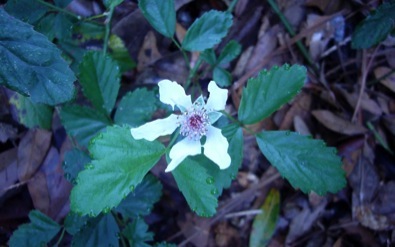Dewberries: Rubus Trivialis
Dewberries go far in the world, for a lowly vine. They can reach up to 15 feet long, one node root at a time.
Essentially a blackberry on the ground, Dewberries are a delicious addition to any foraging. Besides me and thee, the Dewberry is very popular with bees. The flowers attract honeybees, bumblebees, mason bees, leaf-cutting bees, cuckoo bees and miner bees. The flowers also attract butterflies and skippers. The berries, actually drupes, are important summer food for many birds including red-headed woodpeckers, bluebirds, northern cardinals, and wild turkeys. The raccoon, fox squirrel, chipmunk and white-footed mouse eat the fruits. The cottontail rabbit and white-tailed deer browse on the leaves and stems. In fact, during lean years the Dewberry is an extremely important deer food, but then again, so too is poison ivy. Only humans and primates are allergic to poison ivy.
The Southern Dewberry (Rubus trivialis, ROU-bus triv-ee-AY-liss) differs some from the more widespread Common Dewberry (Rubus flagellaris.) While both have prickles, the Southern Dewberry has bristles, the Common Dewberry does not. What’s the difference between prickles and bristles? It’s the amount of little spines you catch your finger on. A few are a prickles, a lot are bristles.) Also, the Southern Dewberry is evergreen, the Common Dewberry is not. The family the dewberry is in in some 250 genus strong, 26 of them in the southern United States. And the family has been around a long time according to fossil records, some 30 million years give or take a million or two the experts tell us. A whole lot of creatures have enjoyed them over the millennia.
Per usual, the botanical name for Dewberry, Rubus trivialis, is part Dead Latin and bastardized Greek. Rubus is a Roman word meaning red, the hair and or bristles on the stems often make them look reddish. Trivialis refers to the common occurrence of this plant. While it’s also the source of the English word “trivial” it really means “three ways” or crossroads. In Greek Tria is three and Via is force or way. Why “crossroads” means trivial is anyone’s guess but I would suppose crossroads are far less important than the main road, thus we have mainline and trivial.
Dewberries specifically are found Pennsylvania south to Florida and west to Colorado and Texas. Blackberries are found around the world. For example, the Dewberry is listed as an noxious weed in Tasmania. Imagine, a people so removed from nature that an abundance of delicious berries is a nuisance. Hmmmm…. A 2007 study showed a blackberry leaf extract was good at reducing the formation of wrinkles. Seems to me the Tasmanians have the opportunity to be the most wrinkle-less folks on the planet. See my article on Blackberries.
Green Deane’s “Itemized” Plant Profile
IDENTIFICATION; Trailing vine, often roots at the nodes, twigs have reddish hairs; prickles small and scattered. Leaves alternate, variable in size and shape; leaflets elliptic to narrow-oval, twice as long as wide; hairless, toothy. Blossom has five petals, white to pink; pistils many, stamens numerous
TIME OF YEAR: Spring in Florida, June and July in northern climes. Dewberries ripen before other blackberries.
ENVIRONMENT: Edges of woods, roadsides, old fields. Likes most soils, can grow in full sun or some much shade.
METHOD OF PREPARATION: Black fruit, off the vine or prepared like any fruit berry. Leaves can be made into a tea, long used to treat diarrhea.


